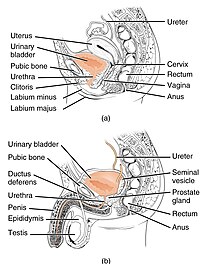
Photo from wikipedia
female and 77 years old on average (Table 1). The prevalence of pressure injuries was 4.8%, with 1.7% of all hospital patients (≥65 years) developing a hospital-acquired pressure injury (Table… Click to show full abstract
female and 77 years old on average (Table 1). The prevalence of pressure injuries was 4.8%, with 1.7% of all hospital patients (≥65 years) developing a hospital-acquired pressure injury (Table 2). Patients with an incontinenceassociated dermatitis had a lower risk (OR 0.200; CI 0.087– 0.456) of having a pressure injury in the sacral or buttock regions than patients without an incontinence-associated dermatitis (Table 3). Dual incontinent patients, meanwhile, had a higher risk (OR 1.644; CI 1.044–2.564) and patients with a disease of the skin a twofold higher risk (OR 2.403; CI 1.143–5.052) of suffering from a hospital-acquired pressure injuries in the sacral or buttock regions than patients (≥65 years) that did not have a dual incontinence or a skin disease (Table 4). Our results are in contrast to the findings of other studies that reported an increased likelihood of acquiring pressure injuries when suffering from incontinence-associated dermatitis. One reason for this difference could be that specific treatments for incontinence-associated dermatitis, such as skin cleansing, re-recommended in the geriatric population, and therefore, these treatments were carried out more often in this high-risk group. Skin cleansing can lead to more skin inspections in the sacral area including the buttocks, and therefore, the first signs of a pressure injury can be detected much earlier. One limitation of this analysis was the inclusion of catheterised residents in the data. This might have had masked a possible relationship with pressure injuries. Besides, due to the cross-sectional design of the study, it is not possible to deduct causal relationships between the variables. Our results showed that incontinence-associated dermatitis was associated with a higher risk for pressure injuries in the sacral or buttock regions. On the other side, dual incontinence was associated with a lower risk for hospital-acquired pressure injury in the sacral or buttock regions. However, as one high-risk groups are geriatric patients (≥80 years) and one major setting where pressure injuries occur is within nursing homes, a study focus on this setting specifically in the geriatric population is warranted. Additionally, we recommend that older hospitalised patients (≥65 years) with dual incontinence, diabete mellitus or other known dermatological problems need to receive preventive skin care intervention.
Journal Title: Australasian Journal of Dermatology
Year Published: 2019
Link to full text (if available)
Share on Social Media: Sign Up to like & get
recommendations!